
Dixie Highway was a United States auto trail first planned in 1914 to connect the Midwest with the South. It was part of a system and was expanded from an earlier Miami to Montreal highway. The final system is better understood as a network of connected paved roads, rather than one single highway. It was constructed and expanded from 1915 to 1929.
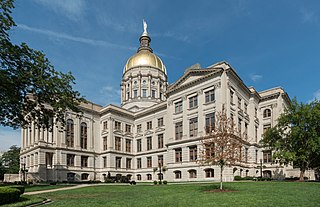
The Georgia State Capitol is an architecturally and historically significant building in Atlanta, Georgia, United States. The building has been named a National Historic Landmark which is listed on the National Register of Historic Places. As the primary office building of Georgia's government, the capitol houses the offices of the governor, lieutenant governor, and secretary of state on the second floor, chambers in which the General Assembly, consisting of the Georgia State Senate and Georgia House of Representatives, meets annually from January to April. The fourth floor houses visitors' galleries overlooking the legislative chambers and a museum located near the rotunda in which a statue of Miss Freedom caps the dome.

The Sons of Confederate Veterans (SCV) is an American neo-Confederate nonprofit organization of male descendants of Confederate soldiers that commemorates these ancestors, funds and dedicates monuments to them, and promotes the pseudohistorical Lost Cause ideology and corresponding white supremacy.
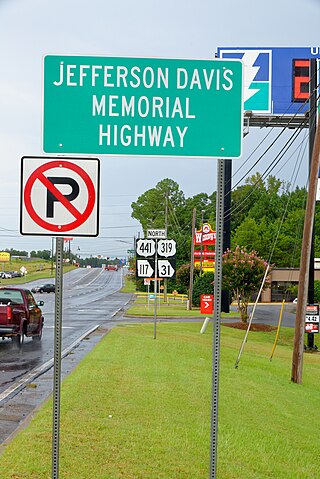
The Jefferson Davis Highway, also known as the Jefferson Davis Memorial Highway, was a transcontinental highway in the United States in the 1910s and 1920s that began in Arlington, Virginia, and extended south and west to San Diego, California; it was named for Jefferson Davis, President of the Confederate States, United States senator, and Secretary of War. Because of unintended conflict between the National Auto Trail movement and the federal government, it is unclear whether it ever really existed in the complete form that its United Daughters of the Confederacy (UDC) founders originally intended.

The Confederate Monument in Owensboro, Ky., was a 16-foot-tall, two-part object — a 7-foot-tall bronze sculpture atop a 9-foot-tall granite pedestal — located at the southwest corner of the Daviess County Courthouse lawn, at the intersection of Third and Frederica Streets, in Owensboro, Kentucky. Nearly 122 years after the monument was dedicated in September 1900, the monument was dismantled in 2022, beginning with the removal of the sculpture in May 2022; the sculpture was placed in storage, pending a decision on what to do with it.
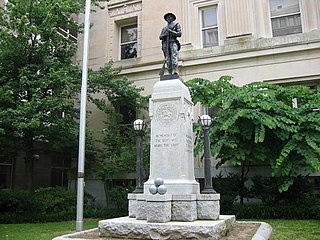
The Confederate Soldiers Monument was a memorial to the soldiers from Durham County who fought for the Confederate States of America in the American Civil War. The statue was seriously damaged by protestors and removed from public view on August 14, 2017.

More than 160 monuments and memorials to the Confederate States of America and associated figures have been removed from public spaces in the United States, all but five since 2015. Some have been removed by state and local governments; others have been torn down by protestors.

Jefferson Davis Park is a private park located outside Ridgefield, Washington, in the southwestern portion of the state. The granite markers of the unofficial Jefferson Davis Memorial Highway are at the center of the park surrounded by Confederate flags. Operated by the Pacific Northwest chapter of the Sons of Confederate Veterans, the park commemorates Jefferson Davis, the pro-slavery President of the Confederate States of America.

The Confederate Soldier Memorial, or Confederate Monument, is located in the Maple Hill Cemetery in Huntsville, Alabama.
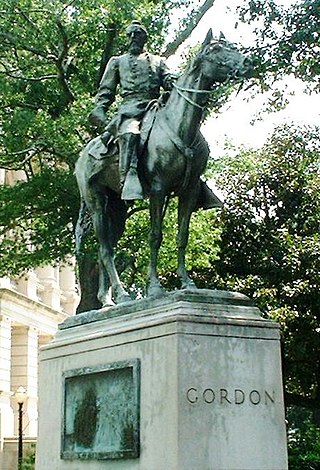
The equestrian statue of John Brown Gordon is a monument on the grounds of the Georgia State Capitol in Atlanta, Georgia, United States. The monument, an equestrian statue, honors John Brown Gordon, a general in the Confederate States Army during the American Civil War who later become a politician in post-Reconstruction era Georgia. Designed by Solon Borglum, the statue was dedicated in 1907 to large fanfare. The statue has recently become a figure of controversy over Gordon's racist views and associations with the Confederacy, with some calling for its removal.
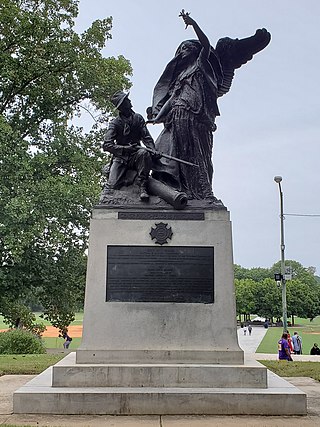
The Peace Monument is a public monument in Atlanta, Georgia, United States. Designed by Allen George Newman, the monument is located in Piedmont Park and was erected in 1911 by members of the Old Guard of the Gate City Guard, a Confederate-era militia, as a show of national unity in the years following the American Civil War. The monument has been the subject of controversy recently, with some calling for its removal as a symbol of the Lost Cause of the Confederacy.

The Confederate Obelisk is a large Confederate monument located in the Oakland Cemetery of Atlanta, Georgia, United States. The structure, a tall obelisk located in the cemetery's Confederate section, was dedicated in 1874. Due to its connection to the Confederate States of America, the monument has been vandalized repeatedly.
















